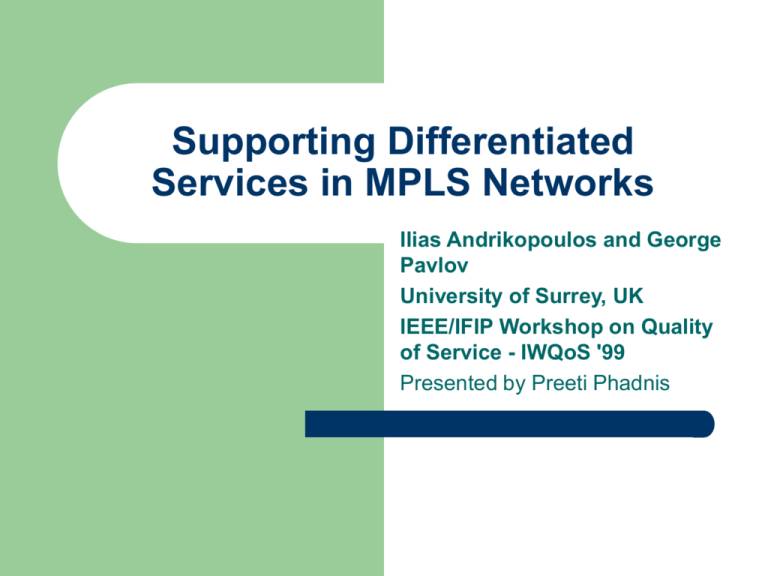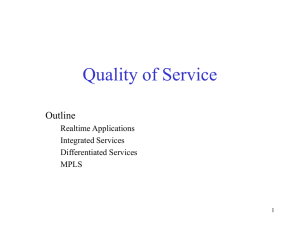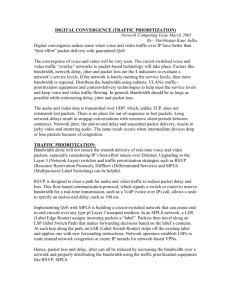Supporting Differentiated Services in MPLS Networks
advertisement

Supporting Differentiated Services in MPLS Networks Ilias Andrikopoulos and George Pavlov University of Surrey, UK IEEE/IFIP Workshop on Quality of Service - IWQoS '99 Presented by Preeti Phadnis Outline Introduction Differentiated Services Multi-Protocol Label Switching Differentiated Services and MPLS Conclusions Introduction MPLS – new approach of integrating IP with ATM Also known as IP switching, IP over ATM, or Layer 3 Switching Tries to provide best of both worlds by integrating the efficiency and simplicity of IP routing together with the high speed switching of ATM Introduction Differentiated services define a model for implementing scalable differentiation in the Internet. Packets are classified, marked, policed and shaped at edge of the network. Per-flow state does not need to be maintained in the interior network nodes which leads to increased scalability. MPLS good candidate for DiffServ. Differentiated Services These allow IP traffic to be classified into a finite number of service classes that receive different router treatment. No attempt to make end-to-end guarantees. DS field or Codepoint (DSCP) is Type of Service field in IPv4 Traffic Class Field in IPv6 No signaling protocols required Amount of state information required per node is proportional to number of service classes and not proportional to the number of application flows. Service Level Agreement (SLA) The SLA is a contract, established either statically or dynamically, that specifies the overall performance and features which can be expected by a customer. Differentiated Services are for unidirectional traffic only. The subset of the SLA which provides the technical specification of the service is referred to as the Service Level Specification (SLS). Traffic Conditioning Specification (TCS) A profound subset of the SLS is the TCS which specifies detailed service parameters for each service level. These service parameters include service performance parameters (e.g. throughput, latency, drop probability) and traffic profiles corresponding to the requested service. TCS may define the marking and shaping functions to be provided. Differentiated Services Architecture Elements are generally placed in ingress and egress boundary nodes of a differentiated services domain and in interior DS-compliant nodes. Packet Classifiers Classification is done with packet classifiers, which select packets based on the content of packet headers according to well-defined rules determined by the Traffic Conditioning Agreement. Behaviour Aggregate (BA) classifier, which selects packets based on the DS Codepoint only Multi- Field (MF) classifier, which performs the selection based on the combination of one or more header fields. Traffic Conditioners Meter: measures the temporal properties of a traffic stream selected by a classifier. Marker: sets the DS Codepoint in a packet based on well defined rules. Shaper: delays packets within a traffic stream to cause the stream to conform to some defined traffic profile. Dropper/Policer: discards packets based on specified rules (e.g. when the traffic stream does not conform to its TCS). Packet Classifier and Traffic Conditioner Per-Hop Forwarding Behaviors (PHB) A PHB is a description of the externally observable forwarding behavior of a differentiated services node, applied to a collection of packets with the same DS Codepoint that are crossing a link in a particular direction (called differentiated services behavior aggregate). Each service class is associated with a PHB. PHBs are defined in terms of behavior characteristics relevant to service provisioning policies, and not in terms of particular implementations. PHB Types The Default (DE) PHB is the common, best-effort forwarding available in today’s Internet. The Expedited Forwarding (EF) PHB is a high priority behavior typically used for network control traffic such as routing updates. The EF PHB is defined as a forwarding treatment for a particular differentiated services aggregate where the departure rate of the aggregate’s packets from any DS-compliant node must equal or exceed a configurable rate. PHB Types Finally, the Assured Forwarding (AF) PHB is a means for a provider differentiated services domain to offer different levels of forwarding assurances for IP packets received from a customer differentiated services domain. Four AF classes are defined, where each AF class in each differentiated services node is allocated a certain amount of forwarding resources, e.g. buffer space and bandwidth. Within each AF class, IP packets are marked with one of three possible drop precedence values. In case of congestion, the drop precedence of a packet determines the relative importance of the packet within the AF class. MPLS Multi Protocol – supports protocols even other than IP Supports IPv4, IPv6, IPX, AppleTalk and at the network layer Supports Ethernet, Token Ring, FDDI, ATM, Frame Relay, PPP the link layer Label – short fixed length identifier to determine a route Labels are added to the top of the IP packet Labels are assigned when the packet enters the MPLS domain Switching – forwarding a packet Packets are forwarded based on the label value NOT on the basis of IP header information FEC- Forwarding Equivalence Class A group of packets that require the same forwarding treatment across the same path Packets are grouped based on any of the following Address prefix Host address Quality of Service (QoS) FEC is encoded as the label Label Switching Routers (LSRs) LSR : use link-level forwarding to provide a simple and fast packet-forwarding capability. Label swapping is accomplished by associating fixed-length labels with routes and using the label value to forward packets, including the procedure of determining the value of any replacement label. Depending on the Layer 2 and Layer 3 technologies involved, different label encoding schemes can be used. LSP- Label Switched Path LSP defines the path through LSRs from ingress to egress router LSPs are unidirectional LSP set-up can be Traffic-driven: label-assignment triggered by the arrival of data at LSR Request-driven: Label is assigned in response to normal processing of request based control traffic. Topology-driven: labels are pre-assigned according to existing routing protocol information. LDP- Label Distribution Protocol LDP defines , negotiates and distributes the labels. LDP is the signaling protocol through which one LSR informs its peers of the label/FEC bindings it has made. An LSR may use a discovery mechanism to discover potential LDP peers. MPLS Network As labeled packets are transmitted downstream along the LSP, each LSR examines the label and forwards the packets downstream according to NHLFE 3 Conceptual bases Next Hop Label Forwarding Entry (NHLFE) is used when forwarding a labeled packet. It contains the outgoing interface (next hop), the data link encapsulation used for the transmitted packets, the outgoing label and the operation (add, replace, or remove) to perform on the label stack. Incoming Label Map (ILM) is a mapping from incoming labels to NHLFEs. It is used when forwarding packets that arrive as labeled packets. FEC-to-NHLFE Map (FTN) is a mapping from FECs to NHLFEs. It is used when forwarding packets that arrive unlabeled, but which are to be labeled before forwarding. Differentiated Services and MPLS Placement of packet classifiers, traffic conditioners and PHBs in MPLS network. In this paper only ATM LSRs DSCP in the IP header is not accessible by the ATM forwarding hardware. Solution: Map some part of ATM cell header to DSCP or use LDP Using LDP DSCP is mapped to an LSP at the ingress. Each DSCP/PHB a separate LSP will be established for the same egress LSR. n classes , m egress LSRs, n*m LSPs need to be set up. Label is regarded as behavior aggregate selector. 2 LSPs can be merged into one LSP if the packets they carry belong to same Behavior Aggregate or have the same DSCP. Assumptions MPLS to ATM mapping element in every MPLS DS-compliant node. Assumption that only best-effort LSPs are initially established and new LSPs corresponding to specific Behavior Aggregates need to be set-up. Modifications and Extensions to MPLS LSRs must be DS-compliant. The appropriate PHBs, associated with the various service classes, must also be present in the core DS-compliant LSRs. Mapping element located in the interior nodes will perform the mapping from the currently defined EF, DE and AF classes to ATM. DSCP parameters in both NHFLE and FTN tables Make LDP DS-compliant Downstream-on demand label allocation -to setup end-to end LSPs with the appropriate differential QoS, ensure that all LSRs belonging to the same LSP perform the label binding in an ordered manner. Addition of BA attributes in label binding messages- Differentiated services QoS is mapped directly to the LDP CoS TLV. The PHB-to-ATM mapper will then be responsible for calculating the necessary QoS parameters (e.g. bandwidth allocation). General switch Management Protocol General Purpose Management Protocol to manage and control the ATM switch and its functions like VC establishment and release, dynamic QoS negotiation, request of switch statistics and configuration information. A DS-compliant ATM LSR architecture Components TCP/UDP/IP: This is the TCP/IP protocol stack. MPLS Daemon: The main process of a LSR. It is where the core of the MPLS protocol is actually located. DS-compatible LDP Daemon: An LDP daemon process, running on top of TCP/UDP/IP, and which supports the extensions mentioned above. It is used to exchange LDP PDUs with peer LDPs. It also interfaces to the DiffServ module and the MPLS daemon. Admission Control: It is used to find out whether available resources are sufficient to supply the requested QoS. Routing Daemon: This is the traditional routing protocol daemon (e.g. OSPF, BGP) running on IP routers. Components DiffServ Module: It is responsible for identifying the DSCP at the ingress LSR in order to associate it with the appropriate label. Also, responsible for mapping the PHBs to ATM QoS parameters. Flow MIB: A database for maintaining flow related information, such as per-flow traffic statistics and path information for aggregated flows. This information is needed for resource management. Flow MIB Controller: It is responsible for monitoring the LSR and its flows. It collects statistics which are useful for evaluating the local resources. GSMP Interface: The GSMP protocol is required by the switch controller to control the ATM switch. Example – Non-DS capable MPLS network Topology driven label assignment- end-to end LSP’s are already in place. Each packet belonging to the same stream is mapped to a corresponding FEC at LSR1. Example DS-Compliant MPLS Network LSPs supporting various QoS are not set up. Example DS-Compliant MPLS Network IP packets belonging to a particular traffic stream arrive at LSR1, having already been marked at the source end host or egress router of the originating network to indicate the level of service they expect. At LSR1, the classification and traffic conditioning functions on the specified traffic are performed by the service provider. The network is assumed to have already been provisioned to accept the arriving traffic by statically allocating the necessary resources. The classified IP packets are then checked for their destination IP address and DSCP. These are compared to the entries of the FEC and NHLFE tables. An established LSP which is associated to a FEC element and satisfies the routing and QoS requirements of the stream is found and the corresponding label bound to this LSP is assigned to the IP packets. Conclusions MPLS together with Differentiated Services can be easily combined to form a simple and efficient Internet model capable of providing applications with differential QoS. The need for complex IP and ATM signaling protocols like RSVP and P-NNI respectively is eliminated. No per-flow state information is required leading to increased scalability. A lightweight signaling protocol like LDP with the appropriate extensions along with the ATM traffic management mechanisms, which are already there and implemented in hardware in the ATM switches, provide all the necessary functionality and flexibility required by large networks in a simple manner and without sacrificing precious resources.







